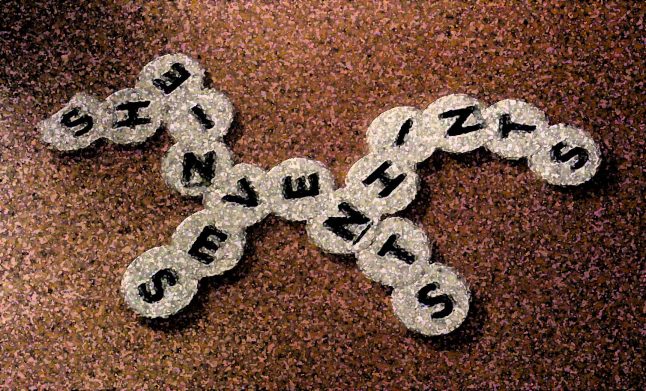Whether you’re playing Scrabble or Boggle, solving cryptic crosswords or attempting the numerous word puzzles that you might find in a daily newspaper, one thing is for certain: the ability to rearrange a set of letters into some kind of recognizable pattern -more easy: to solve an anagram- is a key skill.
Shortened from the Greek “Ana-grammatismos” (literally meaning “to transpose letters”), an anagram is a word or phrase, the letters of which can be rearranged into a different word or phrase. Indeed, in its widest sense, an anagram may start off as a simple jumble of letters (such as in a collection of seven tiles on a scrabble tray), as long as these letters can then be reorganised into an identifiable word.
So, if anagrams are such an important part of so many word-games and word-puzzles, how do we go about improving our ability to solve them? Is there a set of rules to help us towards the solution? Or must we simply rely on some kind of innate ability to spot patterns?
Well, although it is undoubtedly true that some people are better than others (at finding a word or phrase hidden inside a jumble of apparently random letters), the good news is that there are some simple techniques we can use that, over time, will help us to improve our success rate.
So here, in no particular order are my top seven tips for solving anagrams:
1) Circle
Wherever practical, attempt to place the letters randomly into a circular pattern. This not only breaks up the original order and any potentially misleading sound combinations but it also makes it easier to see all the different letter-groupings that you might be able to connect together.
2) Suffix or Prefix
Search for any potential suffixes or prefixes in the letters. These are common letter groupings that either end or start other words. For example, you might find suffixes such as: -ING, -NESS, -LY, -ISM, -ED, -ER, -RY, -OUS, -MENT or –TION. Or you might look for prefixes such as UN- , DIS-, SUB-, RE-, DE-, IN-, AB-, AD- or EX-. If you separate these from the other letters, those that remain become easier to handle, being obviously fewer in number. Please be aware that the clever anagram compiler may often avoid words that begin or end in this way so if this does not work you will need to consider some other methods.
3) Common and Uncommon Pairings
Look for letters that frequently go together and try combining them. The most obvious of these is the letter Q which will almost always be followed by a letter U. Also, the letter H, unless it is at the start of a word, will tend to follow one of the letters C, G, P, S, T or W.
At the same time, it is a good idea to eliminate any unlikely pairings of letters, those that do not tend to appear next to each other in most English words.
4) Consonants Only
The key letters in any particular grouping tend to be the consonants. These give shape and sound to a word. So ignoring vowels and concentrating on consonants can often pay dividends. Try placing the consonants in a circle so that you can more easily combine them.
Separating consonants from vowels can also have an additional advantage, in situations where the number of vowels is severely limited or alternatively, when the number of vowels compared to the number of consonants is unusually high.
Firstly, when the number of vowels is small, it is more than likely that consonant combinations will occur. So it helps to look out for consonant pairs such as PR-, SP- etc or even combinations of three consonants such STR- and -GHT.
On the other hand, when the number of vowels is relatively large, we should be looking for common vowel combinations such as IE, EA, OU etc or even triples such as IOU (often followed by a letter S). Three vowel combinations are relatively uncommon, however, so it might be worth learning some of the words that contain them (for example: BEAUTY and GAIETY)
5) Memorising multiple words
If you spend any length of time trying to solve anagrams, certain multiple word groups (words that are anagrams of other words) will begin to crop up on a fairly regular basis. Trying to learn and memorise such multiple word groups can be useful in future. Here are some to get you started.
ANGEL = GLEAN = ANGLE
EMIRATE = MEATIER
CHESTY = SCYTHE
OVERNEAT = RENOVATE
MOROSE = ROMEOS
SPECIAL = PLAICES
6) Other hints?
If the anagram is part of a cryptic crossword there will be other hints in the clue that you can use to help you. Jot down synonyms for the other key words in the clue or indeed any words that seem to fit the theme. You never know, you might write the answer to your anagram as part of a general brainstorming of ideas that develop from the rest of the crossword clue.
7) PRACTICE!
And finally, don’t forget that, as with any other skill, practice makes perfect. The more you try to solve anagrams and the more successes you have, the better you get.
So don’t lose heart. Following one or more of my helpful hints will help you get quicker and slicker at solving anagrams and will ultimately give you the warm glow that comes from a puzzle that has been well and truly solved. If you like to share your strategies, fell free to use the comment box below.
Good luck!

